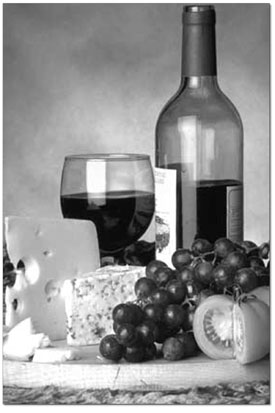|
| ||
| Wine and cheese demystified
by Ari LeVaux They don’t call wine the “nectar of the gods” for nothing. The world’s oldest fermented beverage has facilitated many heavenly feelings and other godlike manifestations of drama and paradise. And no day in paradise would be complete without a feast. And nowhere does wine become more heroic and beautiful than at the table. Like french fries need ketchup and salmon wants a squirt of lime, a nicely cooked piece of red meat needs a sip of red wine. It’s a love story: the meat and wine complete each other – and me. Beyond the red meat and I, wine completes many a good meal, taking flavors much farther than they could go alone and magnifying the pleasure. And few people seem to complain about the buzz. But not all pairings are as foolproof as bloody meat with blood-red wine. And some people actually have refined-enough sensibilities that they distinguish their wines beyond my caveman categories of red and, ugh, what’s that other kind? Consider the mating of wine and cheese, a culinary cliché if there ever was one – but only so because it’s the stuff of mystique, pleasure, disagreement and enough stress to keep suburban shrinks in Château Lafitte Rothschild until the cows come home. Successful wine and cheese pairing comes down to a slippery combination of science, art, luck, and the personality and physiology of the taster. But cocktail party planners needn’t freak out, because the whole tradition is based on the fact that wine and cheese simply taste good together. Sure, some combinations are better than others, but you can’t go too far wrong. That’s because there are some common laws at work underneath it all. I’ve packaged a few of these principles into cocktail-sized portions. Hopefully, getting a handle on these rules will help you find your own answer to the wine and cheese equation. At the very least, you might save some money. Acid loves fat. This is the most important thing to know here: Acidic foods eaten with fatty foods make each other taste better. Whether it’s lemon butter, oil and vinegar, tomato and mayo, wine and meat, or wine and cheese, when acid and fat converge and dance in your mouth, it rules. That’s rule #1. Rule #2: Young wine loves cheese. It turns out that one of the main reasons cheese and wine go together – beyond the acid/fat dance – is that cheese can help mask the taste of under-aged wine. The astringent flavor characteristic of some young red wines comes from tannins, which are plant-based molecules derived primarily from grape seeds, peels and stems. Over time, tannins break down and mellow, becoming an important part of a wine’s unique and complex terroir (a French word to describe the part of a wine’s flavor that’s rooted in the landscape in which the wine was produced). Because tannin breakdown can take time, many under-aged wines have too many tannins for most palates. The fat in cheese protects your mouth from astringent tannins. Rule of Terroirism: Earth loves earth. Pairing a wine with a cheese from the same region will allow the respective terroires of the wine and the cheese to share the secrets of their home ground. Ask anyone from France. Flashback Rule: Acid likes acid. Some people insist that cheese of high acid content – goat cheeses are generally very acidic – should be paired with wines of similarly high acidity, like Sauvignon Blanc. They might be hallucinating. Controversial Rule: Bad wine loves cheese. It turns out that cheese masks more than just tannins. In research reported in New Scientist, trained wine tasters were presented with cheap and expensive versions of four different varieties of wine. They evaluated the strength of various flavors and aromas in each wine – both alone and when preceded by eight different cheeses. They found that cheese suppressed berry and oak flavors, as well as sourness and astringency. Only certain “buttery” aromas were enhanced by cheese – possibly because cheese contains a molecule responsible for a buttery wine aroma. Hildegarde Heymann of UC Davis, co-principal investigator of the study, suggests that proteins in the cheese may bind to flavor molecules in the wine, or that fat from the cheese may coat the mouth, deadening the tasters’ perception of the wines’ flavors. So even while the acid of the wine tastes generally good as it cuts through the fatty coating on your mouth, that same coating might prevent you from perceiving the wine’s more subtle flavors. You would get, according to Hildegarde and company, virtually the same pleasure from a lesser wine. If that’s the case, perhaps it would make sense to not waste your money on fine wine when pairing it with cheese. If the cheese raises even cheap wine to godlike status, better to spend your money on the cheese. Of course, there are many who’d call Hildegarde’s conclusions total balderdash, foodies and snobs who swear that a good cheese will taste better with a fine wine than a cheap one, and vice-versa. To find out where you stand, you can test yourself. Start with a good cheese, say a Saint-Nectaire, and pair it with some cheap cabernet. Then eat the cheese with a good Bordeaux Cru Bourgeois. If you can taste the difference, then delving further into the realm of pairing would probably be worth your while. If you can’t taste the difference, then you probably know all you need to know about wine and cheese. •
|


